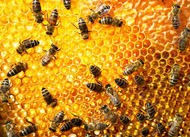Apis dorsata:
It is the largest of the honey bees. It builds an open single comp of huge size
about a meter in diameter. The comb is fully exposed and huge from inaccessible
branches of trees, along the sides of steep rocks in the forest and even from the
walls, rafters and other parts of buildings. It produces plenty of honey and the
annual yield from a colony is about 37 kg. The rock bee honey represents a major
portion of the honey sold in our markets. It is impossible to domesticate it because
of its irritable and ferocious nature.
Apis florea:
It is known as little bee since it is the smallest of three species of Apis. It
is seen only in the plaints. It also builds single but small combs on bushy plants
and corners of roofs. It yields very little honey, about 0.5 to 1.0 kg. per year
from a colony.
Apis indica
 It is the common Indian bee found both in the forests as well as in plains throughout
our country. It is smaller than rock bee but larger than little bee. This bee builds
many parallel combs in the cavities and hollows of trees, caves and such other hidden
sites. It is mild and is the only form capable of being domesticated and is commonly
reared in South India. The annual yield of honey is 2 to 5 per colony
It is the common Indian bee found both in the forests as well as in plains throughout
our country. It is smaller than rock bee but larger than little bee. This bee builds
many parallel combs in the cavities and hollows of trees, caves and such other hidden
sites. It is mild and is the only form capable of being domesticated and is commonly
reared in South India. The annual yield of honey is 2 to 5 per colony
Melipona iridipennis:
The dammer bee is very tiny with a vestigial sting and is different from the former
three species in appearance and habits. It inhabits crevices in walls and hollow
trunks of trees. The comb is made up of a dark material called ‘cerumen’ which is
a mixture of wax and earth or resin. It is very poor honey gatherer and yields only
60 to 180 per year.
Apis mellifera:
It is the Italian bee which swarms less and has good honey gathering qualities,
yielding about 45-180 kg per year.